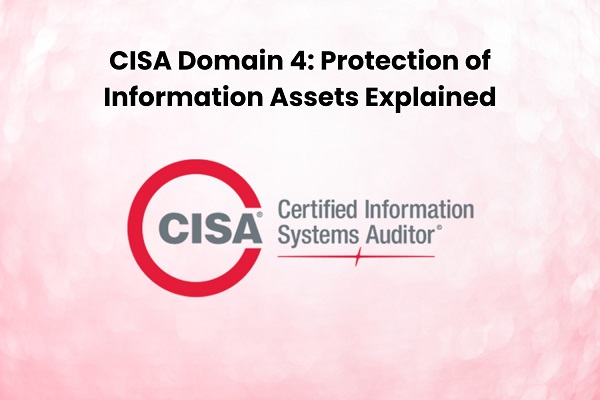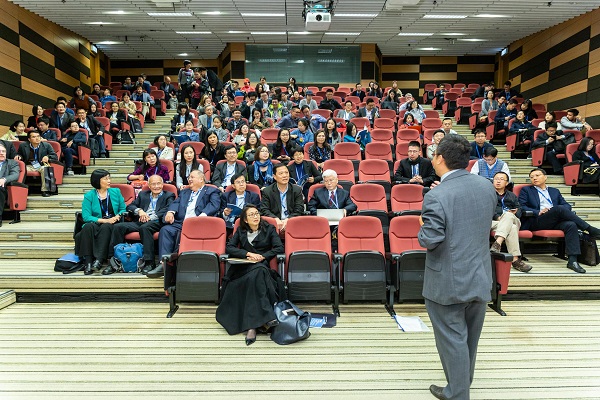Starting on the path to achieving CISA Certification necessitates having a thorough understanding of all the many areas that make up this esteemed certification. Domain 4—Protection of Information Assets—is the most important when building an organisation’s digital fortress. In this blog, we will discuss CISA Domains and information asset protection, ensuring a solid defence against online attacks.
Table of Contents
- What is CISA Certification?
- The CISA Domains
- Protecting the Digital Ramparts with Domain 4
- Information Security Policies, Standards, Procedures, and Guidelines
- Information Classification and Handling
- Asset Lifecycle Management
- Data Privacy Practices
- Physical and Environmental Controls
- Security Architecture and Design
- Identity and Access Management (IAM)
- Security Testing, Surveillance, and Monitoring
- Incident Response and Recovery Planning
- Mastering Domain 4 for CISA Success
- Conclusion
What is CISA Certification?
Before going into Domain 4, let us quickly review the fundamentals of CISA certification. An internationally recognised benchmark for evaluating and auditing an organisation’s business and information technology systems is the Certified Information Systems Auditor (CISA) credential. It is evidence of proficiency in information system assurance, control, and security audits.
The CISA Domains
Domains are the thematic categories encompassing the primary areas of knowledge within the CISA certification. Every domain contributes to the comprehensive understanding of information systems auditing. Domain 4—the Protection of Information Assets—is an essential component within this paradigm.
Protecting the Digital Ramparts with Domain 4
Information Security Policies, Standards, Procedures, and Guidelines
A clear collection of rules, standards, processes, and guidelines is the foundation of every strong information security plan. Domain 4 immerses candidates in creating and putting these essential components into practice. Strict attention to detail in the creation of policies guarantees compliance with legal and industry standards, establishing the foundation for a safe information environment.
Information Classification and Handling
Not all information in digital data is equally important. Domain 4 instructs professionals in discernment, helping them handle and categorise data according to its criticality and sensitivity. Through an awareness of the subtleties involved in information classification, auditors can plan a focused strategy for protecting the most valuable assets.
Asset Lifecycle Management
Within a company, all assets—tangible or intangible—go through a lifetime. Domain 4 presents the notion of Asset Lifecycle Management, stressing the necessity of an organised strategy from procurement through disposal. This reduces possible hazards by guaranteeing the safety of assets while they are being used actively and their appropriate retirement and disposal.
Data Privacy Practices
The significance of data privacy measures cannot be emphasised as data breaches happen more frequently. Domain 4 provides professionals with the skills and resources to create and manage robust data privacy frameworks. Comprehending data privacy’s ethical and legal implications in the current regulatory environment is critical.
Physical and Environmental Controls
Information assets are not just found in the digital sphere; their physical and environmental contexts are also very important to their security. Domain 4 deals with deploying security measures, including monitoring, access controls, and environmental protections, guaranteeing a complete defence against digital and real-world attacks.
Security Architecture and Design
An architecture with resilience is essential when it comes to cyber threats. Domain 4 focuses on creating and putting into practice security architectures that can fend off complex threats. Professionals learn how to build an environment that is safe and responsive to new threats, starting with network design and ending with encryption techniques.
Identity and Access Management (IAM)
One of the most critical aspects of asset protection is managing access to sensitive data. Domain 4 delves into the topics of Identity and Access Management, offering experts guidance on how to put strong authentication and authorisation systems in place. Not only is limiting access the aim, but it also ensures authorised people can easily traverse the digital terrain.
Security Testing, Surveillance, and Monitoring
Proactive security measures include ongoing testing, monitoring, and surveillance. Domain 4 highlights the significance of maintaining a competitive edge through consistent security evaluations, intrusion testing, and attentive observation. Maintaining a robust information security posture requires promptly identifying anomalies and vulnerabilities.
Incident Response and Recovery Planning
No security strategy is complete without a clear incident response and recovery plan. Domain 4 gives experts the know-how to handle the aftermath of a security incident. This feature ensures that companies can recover from security breaches with resilience, from quick action to thorough preparation.
Mastering Domain 4 for CISA Success
Becoming an expert in CISA Domain 4 takes more than just theory. Applying the concepts acquired in practical, hands-on ways in real-world situations is necessary. A successful CISA candidate becomes a strategic defender of the organisation’s general well-being and a custodian of information assets.
Conclusion
Domain 4 stands out among the CISA domains as a helpful light that leads experts through the information asset protection process. This domain captures the essence of protecting digital fortresses, from creating strong regulations to comprehending the subtleties of data protection. Candidates for the CISA certification will discover a plethora of information in Domain 4 that will help them pass the test and provide the skills they need to succeed in the modern cybersecurity environment.







